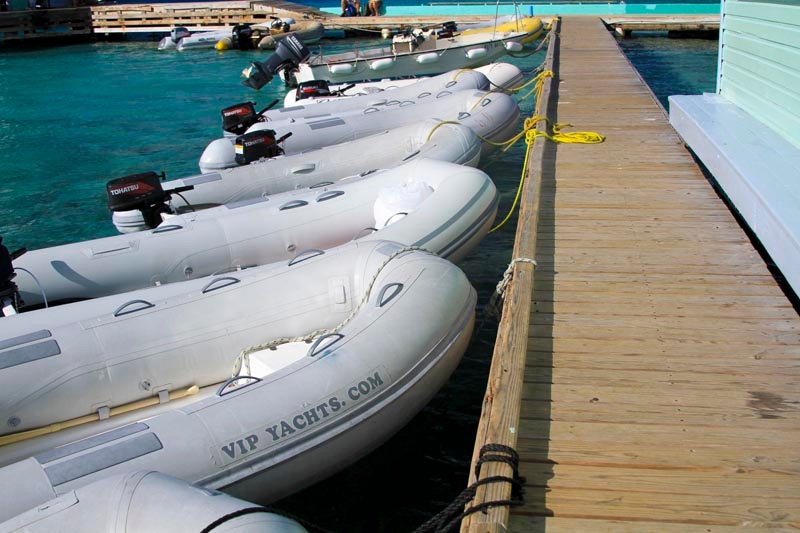
Going Ashore
The sailboat will take you from island to island, but once you reach an anchorage, you will often use the dinghy to travel to shore. Traveling in the dinghy is fun, and you’ll occasionally find yourself tying up to a dinghy dock with many other boats in the more popular locations.
Exercise care when snorkeling or swimming in any anchorage. Boats maneuvering in an anchorage may not be on the lookout for swimmers.
Sea Sickness
Whether you call it sea sickness, motion sickness, or mal de meer, you should take precautions to prevent it. Motion sickness can happen to anyone, even old salts. Motion sickness is a miserable experience, but with some precautions you can avoid or minimize it.
Visit your physician before your trip and ask for recommended remedies which may include patches, bonine, or other treatments. Your physician can educate you on the risks and benefits of each so you can make a decision.
Even after extensive studies by NASA and the Navy, there is not a definitive understanding of why motion sickens occurs or how to prevent it.
If you do get seasick, remind yourself that as miserable as you feel, it should soon pass. If you are concerned about motion sickness, keep in mind that catamarans are much more stable in the water than monohulls. You may want to choose a catamaran if you are concerned about queasy crew.
Showering
It’s a paradox: although you are floating in enough water to fill an ocean, bury pirate treasures, and sink armadas, the one on-board resource in short supply is water. Sailors have perfected the art of water conservation and sailing, and as a crew member, you will get to master the art as well. Your boat will be equipped with a fresh water tank that you will share with everyone on board for cooking, handwashing, and showering. Using this water wisely will mean fewer stops to refill water, giving you more vacation time and saving some money.
There are usually showers in each head (bathroom) as well, and their ingenuity will impress you. To save space, the shower head, toilet, and sink share the same floor space. To shower, you simply close the toilet, move any objects into the bathroom cabinets, and then turn on the shower head, which will get the toilet seat and sink counter wet. A drain in the floor drains the water into the boat’s bilge where it is pumped overboard. You’ll be amazed at the efficiency of it all, and may even find yourself dreaming of redesigning your bathrooms back home by moving your toilet and sink into the bathtub. Check with the Captain before using the onboard shower to ensure there is sufficient water for crew showers.
To maximize water savings, many sailors shower as follows: With the engine off, start by jumping in the ocean and swimming for a few minutes, then climb up on the stern (back) steps to lather up with soap and shampoo, just wearing a swimsuit. Jump in to rinse the soap off, and then climb back up on the steps and use the small shower head at the back of the boat to quickly rinse the salt water off. You will be clean, and will save water — two reasons your fellow crewmates will be more likely to divide treasure with you, should you discover any in your travels.
Heads
“Head” refers either to the bathroom or to the toilet itself, depending on the context. Sailboat heads are wonderful inventions, but must be treated with attention to instructions. A backed-up head will quickly foul the air on board, and if it isn’t able to be cleared by the Captain, the charter companies will have to charge you an extra fee for doing so. The Captain will demonstrate how to use the head for your particular boat. Pay attention. And if you forget how, do not be embarrassed to ask for another quick lesson! Because this is so important, it bears repeating. You will probably forget the head flushing instructions the first time or two, everyone does, so be sure and ask the Captain for a quick refresher lesson whenever needed. Captains would much rather teach flushing instructions than tangle with a backed up head, as reflected in the old pirate captain’s adage, “I be a teacher, not a plumber”.
There is one more important rule of sailboat heads that charter companies will often recommend: “Nothing goes down the head that you didn’t eat.” Any paper or other items will be deposited in the trash, which you will frequently empty throughout the trip. Sending non-organic materials down the head may cause it to back up. Heads usually empty into a holding tank, and then are emptied some distance from shore while sailing. The ocean is an efficient decomposer, and the charter company will let you know how far out to sea you must be before emptying the tanks.
Deck Hatches
If you are an early riser, this next tip is for you. Most cabins on the boat have a hatch with a window in the ceiling. The hatches will be open at night for ventilation, which creates two problems if you want to walk on deck before others awake. First is a tripping hazard: be careful you don’t step through an open hatch or trip over one. Second is a privacy hazard. Below the hatch, the cabin’s occupants may be changing or otherwise in various states of undressedness. At times when other crew may be changing or sleeping, let them know before going for a stroll above their cabins.
